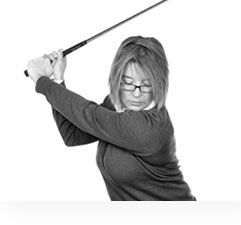 Natalie Adams – PGA Teaching Pro
Natalie Adams – PGA Teaching Pro
The divot that you leave when you hit your golf shot can provide you with some really good feedback as to what's happened during your swing. And can help your crisp your shots up, crisp your connection and gain valuable distance if you are hitting more accurately. So what you want to do is go somewhere where you could actually hit from the turf and then use the divots to give you this feedback. I would suggest if you place the ball next to a tee peg and then strike the ball, you can then look at where the divot's been taken. So if we represent that with a note, the correct place to see your divot has been taken, is from where the tee peg is, the start of the divot should be made and the divot should then be on the left of that tee peg as I'm looking here.
If I notice that my divot is on this side of the tee peg, during my golf swing, I may have gone on to my right foot and then as I come back in, I haven't unloaded the weight off that foot and shifted onto my left. So I'll strike that ball after I've hit the turf; the lowest point for the club will be before the ball and then I'll swing up into the ball. That's going to mean I'm going to lose distance because the club's going to slow down as I strike the turf and then I'll have a lower club head speed into the ball. So what I want to work on doing is taking the divot from in line with my tee peg, that will allow me — if I'm doing that, to make a downward strike onto the ball and then into the turf. So we're looking to hit the ball, then hit down into the turf. So we should notice that from the tee peg, if the ball is in line with the tee peg, the divot's always on the left hand side.
If you’re seeing that your divot is on the right hand side, work on shifting your weight more on to the left and then striking, so that you get a more accurate and consistent hits. As the ball position moves forward for your longer clubs, you should also notice that your divot is a little bit shallower. So for the wedges in the middle of the feet in your stance, you'll take a slightly deeper divot, but for your forward wedge, the ball position more forward with the longer irons and the hybrids, the divot will become a little bit shallower. But use the tee, half the tee opposite the ball and then look at where the divot starts relative to that tee, if its starting in too much on the right hand side, work on shifting your weight more to the left, that will help you strike the ball, then the turf and give you much greater swing speed for the club into the ball. It will help you be more accurate and produce longer golf shots.





